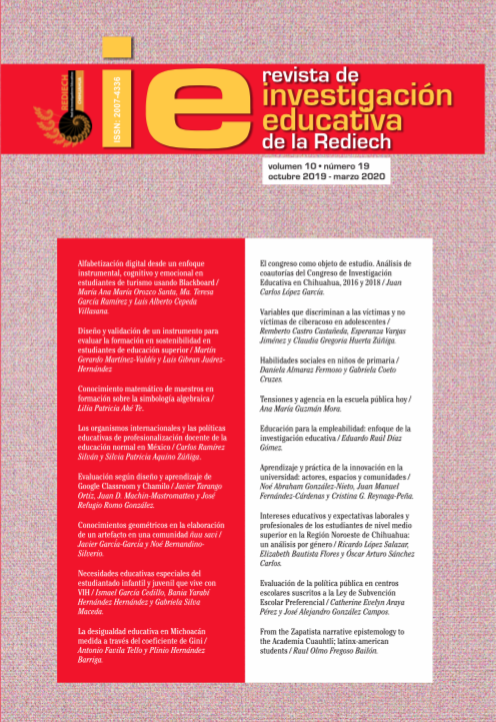Design and learning evaluation of Google Classroom and Chamilo
DOI:
https://doi.org/10.33010/ie_rie_rediech.v10i19.518Keywords:
educational environment, educational software, evaluationAbstract
This reflective, descriptive and exploratory work presents the construction of an evaluation instrument for learning management systems (LMS), according to design and learning parameters, which was used to evaluate Chamilo and Google Classroom. This evaluation was developed in three stages: 1) the materials of an existing course were uploaded to both LMS, and a narrative appreciation of the experiences was documented; 2) a list of advantages and disadvantages was elaborated; and, 3) the instrument that was designed from the specialized literature and the preceding stages was applied. We found that Classroom got slightly better results than Chamilo and that the advantages and disadvantages of each LMS are partly related to their own characteristics. Despite the limitations of the research design used and that we only report professors’ point of view, this approach can contribute for to develop further evaluation parameters that can be applied to other LMS.
References
Cools, E., Evans, C. y Redmond, J. (2009). Using styles for more effective learning in multicultural and e-learning environments. Multicultural Education & Technology, 3(1), 5-16. https://dx.doi.org/10.1108/17504970910951110
Clarenc, C. (ed.). (2013). Analizamos 19 plataformas de eLearning: investigación colaborativa sobre LMS. San Miguel de Tucumán, Argentina: Grupo GEIPITE. Recuperado de http://cooperacionib.org/191191138-Analizamos-19-plataformas-de-eLearning-primera-investigacion-academica-colaborativa-mundial.pdf
Díaz, F. y Castro, A. (2017). Requerimientos pedagógicos para un ambiente virtual de aprendizaje. Cofin, 11(1), 1-13. Recuperado de http://scielo.sld.cu/pdf/cofin/v11n1/cofin04117.pdf
Georgouli, K., Skalkidis, I. y Guerreiro, P. (2008). A framework for adopting LMS to introduce e-learning in a traditional course. Educational Technology & Society, 11(2), 227-240.
Heggart, K. y Yoo, J. (2018). Getting the most from Google Classroom: A pedagogical framework for tertiary educators. Australian Journal of Teacher Education, 43(3), 140-153. Recuperado de http://ro.ecu.edu.au/ajte/vol43/iss3/9
Hemrungrote, S., Jakkaew, P. y Assawaboonmee, S. (2017). Deployment of Google Classroom to enhance SDL cognitive skills: A case study of introduction to information technology course. En 2017 International Conference on Digital Arts, Media and Technology (ICDAMT) (pp. 200–204). https://dx.doi.org/10.1109/ICDAMT.2017.7904961
Izenstark, A. y Leahy, K. (2015). Google Classroom for librarians: Features and opportunities. Library Hi Tech News, 32(9), 1-3. https://dx.doi.org/10.1108/LHTN-05-2015-0039
May, N., Patrón, R. y Sahuí, J. (2017). Ambientes educativos a distancia para la mejora de la enseñanza: Uso de Classroom. Revista Electrónica sobre Cuerpos Académicos y Grupos de Investigación, 4(8), 1-13. Recuperado de www.cagi.org.mx/index.php/CAGI/article/download/151/282
Mohd, I., Mohd, J. y Mohamad, S (2016). Google Classroom as a tool for active learning. En American Institute of Physics Conference Proceedings, (1761). https://dx.doi.org/10.1063/1.4960909
Moussiades, L. e Iliopolou, A. (2006). Guidelines for evaluating e-learning environments. Interactive Technology and Smart Education, 3(3), 173-184. https://dx.doi.org/10.1108/17415650680000062
Najmul, A. y Azad, N. (2015). Satisfaction and continuance with a learning management system: Comparing perceptions of educators and students. The International Journal of Information and Learning Technology, 32(2), 109-123. https://dx.doi.org/10.1108/IJILT-09-2014-0020
Nielsen, J. (2012). Usability 101: Introduction to usability. Recuperado de www.nngroup.com/articles/usability-101-introduction-to-usability
Palacios, J., Gamboa, J., Montenegro C. y Rodríguez, J. (2016). Metric LMS: Educational evaluation platforms. En 11th Iberian Conference on Information Systems and Technologies (CISTI) (pp. 1-6). https://dx.doi.org/10.1109/CISTI.2016.7521434
Pastor, D., Jiménez, J., Arcos, G., Romero, M. y Urquizo, L. (2018). Patrones de diseño para la construcción de cursos on-line en un entorno virtual de aprendizaje. Ingeniare: Revista Chilena de Ingeniería, 26(1), 157-171. https://dx.doi.org/10.4067/S0718-33052018000100157
Perez, S. (2015). Google expands its educational platform “Classroom” with a new API, share button for websites. Recuperado de https://techcrunch.com/2015/06/29/google-expands-its-educational-platform-classroom-with-a-new-api-share-button-for-websites
Ressler, G. (2017). Google Classroom: Now open to even more learners. Recuperado de https://blog.google/topics/education/google-classroom-now-open-even-more-learners
Rodenes, M., Vallés, R. y Moncaleano, G. (2013). E-learning: características y evaluación. Ensayos de Economía, 23(43), 143-159. Recuperado de https://revistas.unal.edu.co/index.php/ede/article/view/42932
Shaharanee, I., Jamil, J. y Rodzi, S. (2016). The application of Google Classroom as a tool for teaching and learning. Journal of Telecommunication, Electronic and Computer Engineering, 8(10), 5-8. Recuperado de http://journal.utem.edu.my/index.php/jtec/article/view/1357/882
Téllez, N. (2014). Ensayo sobre el diseño de ambientes de aprendizaje. Vida Científica, 2(3). Recuperado de https://www.uaeh.edu.mx/scige/boletin/prepa4/n3/e3.html
Wentling, T. y Park, J. (2002). Cost analysis of e-learning: A case study of a university program. Recuperado de http://citeseerx.ist.psu.edu/viewdoc/download?doi=10.1.1.86.5844&rep=rep1
Wong, L., Tatnall, A. y Burgess, S. (2014). A framework for investigating blended learning effectiveness. Education + Training, 56(2/3), 233-251. https://dx.doi.org/10.1108/ET-04-2013-0049




















